| Market Cap: $1.9B TTM revenue: $1.1M YOY return: +797.67% |
CEO: Stephen Altemus Cumulative pay: $714.5k (est) Shareholder value created: $1.3B |
Forecast effort: F Forecast accuracy: F |
 |
Intuitive Machines (NASDQ: LUNR) is the current leading commercial lunar exploration and transportation services provider. NASA’s Commercial Lunar Payload Services (CLPS) program funds transport of NASA cargo to the moon. Presently Intuitive Machines is among 14 companies eligible to bid on CLPS contracts. Intuitive Machines has won four of 11 mission payload contracts. In their first mission, IM-1, the landing failed apparently due to an engineer forgetting to flip a switch to activate the telemetry system laser before launch. An in-flight fix nearly helped overcome the issue, but IM-1 failed to land upright. NASA still categorized IM-1 as successful and awarded Intuitive Machines its final milestone payment. Intuitive Machines followed up with IM-2, which also landed sideways Intuitive Machines’ faces a real challenge from Firefly Aerospace, the commercial company to achieve a fully successful lunar landing. Companies seeking to pay for cargo delivery to the moon are more likely to partner with a proven provider, especially compared to failures of competitors Astrobotic and ispace.
Intuitive Machines’ mission economics have improved. Although IM-1, 2, and 3 each operate at a loss, margins are improving. IM-3 could loose less than $10m and IM-4 is on track to be profitable even without earning NASA’s final milestone payment. However, competition from companies willing to accept losses to gain market share and flight heritage present a challenge.
Intuitive Machines’ latest NASA CLPS contract funds IM-4 at a higher price-per-kilogram than prior missions. Even if IM-4 operates slightly profitable, Intuitive Machines still requires operating capital to cover sales and general administrative costs. Intuitive Machines in 2024 began reporting more revenue from non-lunar transport contracts than from CLPS contracts. Yet Intuitive Machines continues operating at significant loss. All eyes are on if Intuitive Machines can develop a strategy resulting in a potential path to profitability.
2 Minute Version
- Intuitive Machines is one of only two public companies targeting the lunar market (along with Japanese-headquartered ispace). Intuitive Machines primary business focus stems on transporting payload to the lunar surface and providing lunar related data and communication services.
- With a forth mission planned, Intuitive Machine’s primary customer and financial supporter is NASA.
- Intuitive Machines anticipated raising $330m from its SPAC merger, but only generated $55m in committed capital. Soon after going public, a short-lived bubble saw LUNR stock launch from $10 to above $100.
- Intuitive Machines went public forecasting $291 million revenue in 2023 and $759 million in 2024. These forecasts proved widely overstated. However, Intuitive Machines did not suffer to the same extent as other space stocks that also missed their pre-IPO forecasts.
- Intuitive Machines launched its first mission, IM-1, in February 2024. LUNR stock experienced another short-lived 4X gain on news coverage associated with the launch. Failed landing sent the stock back down. The stock experience again large gains following the Trump election. As with many other stocks in the space sector, the gains abated.
- IM-1 generated about $132.3 million in NASA and commercial payload revenue, but at cost of approximately estimated between $145 to $160m. Although a net loss, IM-1 proved a cash haul. During the hype surrounding the mission which sent LUNR stock flying, Intuitive Machines raised (then badly needed) $60.6 million from warrant exercises and other equity transactions.
- IM-2 launched in 1Q 2025, carrying NASA payload valued at $105.0m. It too failed landing upright.
- IM-3 and IM-4 also transporting NASA CLPS cargo will launch in 2025 and 2026. Each of Intuitive Machines first three missions operate at loss. IM-4 is the first mission tracking to operate profitable.
- In April 2023 Intuitive Machines won NASA’s $719 million OMES III contract through joint venture subsidiary Space Network Solutions, LLC. This margins are reportedly extremely low. However this contract has fueled Intuitive Machine’s top line revenue growth seen in 2024.
- In September 2024 IM won another major non-cargo contract: a NASA contract for lunar data relay potentially worth up to $4.8 billion.
- Intuitive Machines extremely successfully used private placements and convertible debt financing to raise significant capital post-SPAC merger. Warrant redemptions and stock sales provided Intuitive Machines with over $300 million in cash as of mid 1Q 2025.
- With no near-term profitability prospect, LUNR stock has already diluted nearly 5x since IPO. It currently trades 20% under its SPAC valuation price implying a four-fold valuation increase since going public.
Financial Disclosures
LUNR’s annual financials require some additional examination when reviewing. First, net profit in 2023 came from favorable accounting treatment of change in fair value of earn-out and warrant liabilities. Operating profit was not driver of 2023 net profit. Such accounting adjustments created $81.7m in other income recorded on LUNR’s financial statement. In 2023, LUNR’s operating loss was -$56.3m, significantly greater than -$5.5m posted in 2022. LUNR in 2024 is on track to post an even larger operating loss.
Revenue declined from 2022 to 2023. But, due to the OMES III contract NASA awarded to LUNR joint-venture subsidiary Space Network Solutions, LLC, rose significantly in 2024. Caution that revenue from OMES III is extremely low-margin (discussed further below). Presently revenue from lunar exploration, which once was Intuitive Machines core business, comprises less than half current revenue.
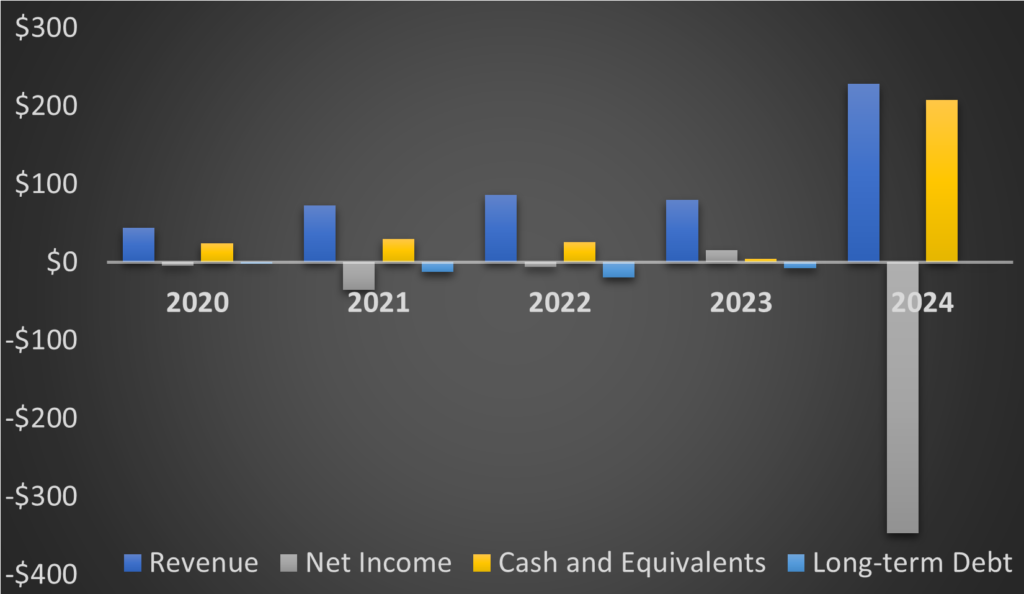
Additional insights may be revealed from examining quarterly reporting. In Q1 2024, LUNR stock price rose on coverage of its first lunar mission, IM-1. The share price rose past warrant strike prices. Warrant holders exercised, profiting themselves while providing more capital for LUNR. In Q1 2024, warrant exercises contributed $50.6 million to LUNR’s coffers. This improved cash position is visible by the spike in cash reported that same quarter. Similarly in 2024 3Q and Q4 and 2025 Q1, LUNR sold even more stock. Cash as of first quarter 2025 is at all-time high.
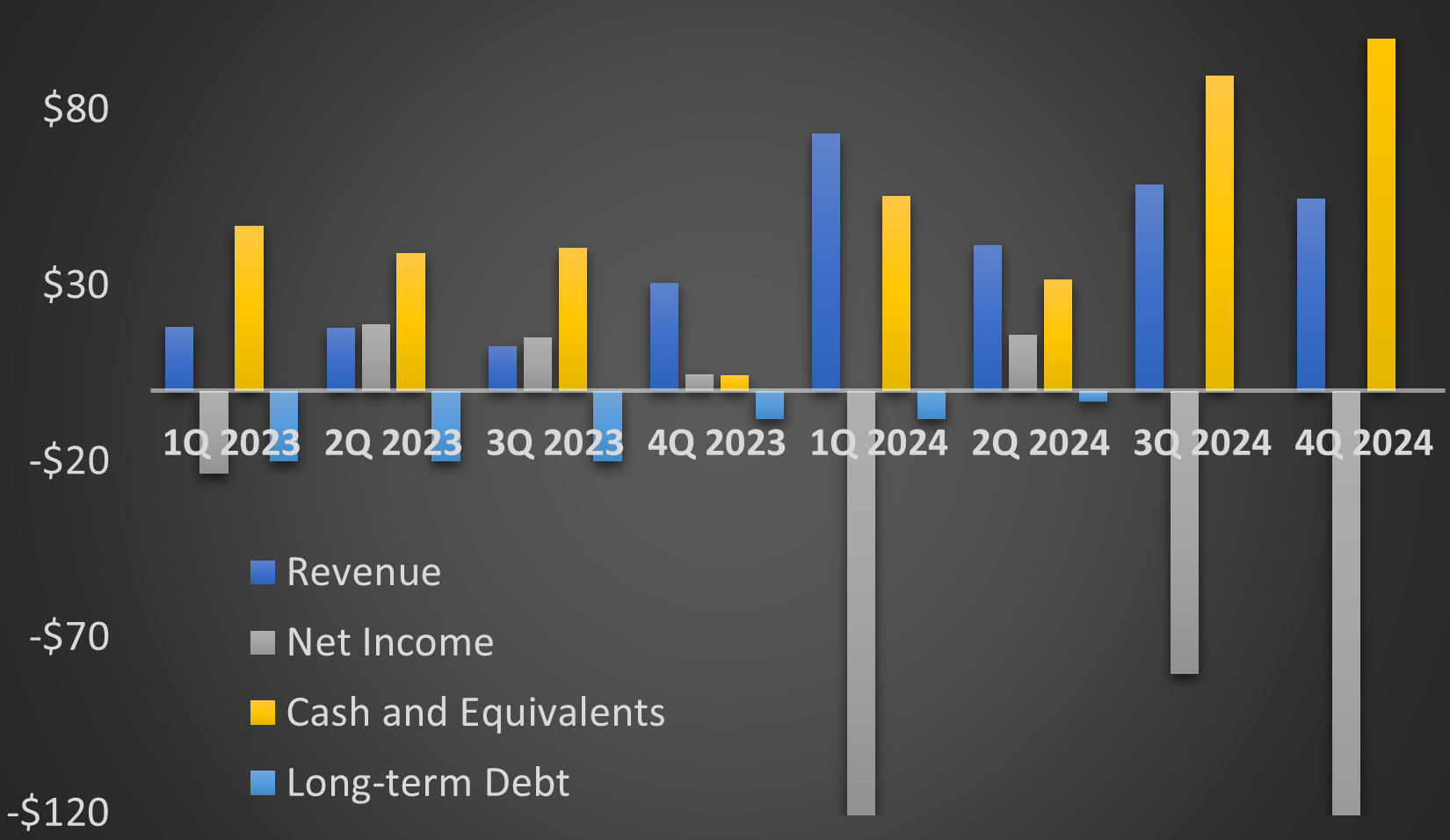
The dilution arising from warrant exercises and new stock sales has not negatively impacted LUNR’s stock price. LUNR remains no nearer to positive cash flow than at IPO. And financial performance lags pre-IPO business projections. And warrants and new share sales have diluted shareholders 5X since IPO. (At IPO there were 13.7 million LUNR shares, expanding to 80.9 million as of November 2024.) Yet LUNR stock at time of writing trades approximately twice its IPO price, implying investors now value Intuitive Machines ten times greater than at IPO.
Intuitive Machines disaggregates revenue into three categories based on contract type. Fixed price contracts comprised the bulk of LUNR’s historic revenue. Fixed price contracts include NASA CLPS contracts for lunar payload transport (i.e. missions IM-1, IM-2, IM-3, etc.). Cost reimbursable contracts now make up the majority of LUNR’s revenue – largely from the aforementioned OMES III contract. Note if it were not for OMES III, Intuitive Machines’ 2Q 2024 revenue would have been near zero. OMES III is driving LUNR’s current revenue growth. But OMES III barely contributes profit to the business.
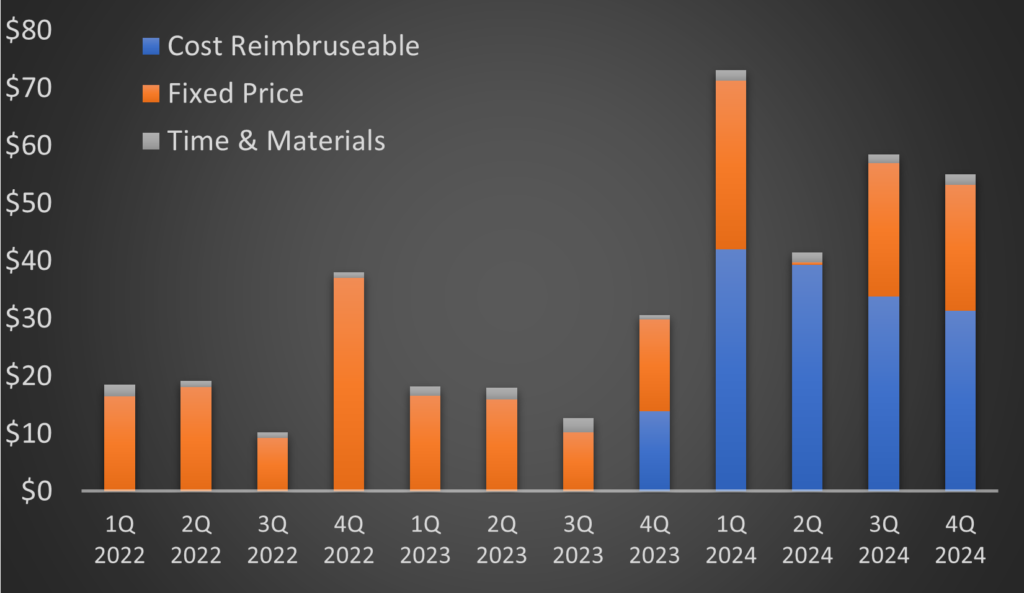
Over the last three years, Intuitive Machine’s revenue from fixed price contracts (i.e. CLPS and commercial lunar payload) has trended downward. NASA’s first three CLPS contracts to Intuitive Machines each subsequently was for less value. NASA paid Intuitive Machines $121.5m for IM-1 (launched 2024). NASA awarded up to $104.1m for IM-2 (launching 2025) and $86.5m for IM-3 (also launching 2025). LUNR’s largest lunar payload customer is NASA. So NASA paying less per mission likely contributes towards declining fixed price contract revenue. However, bucking this trend, NASA’s recent IM-4 payload contract came with a ceiling of $122.2m.
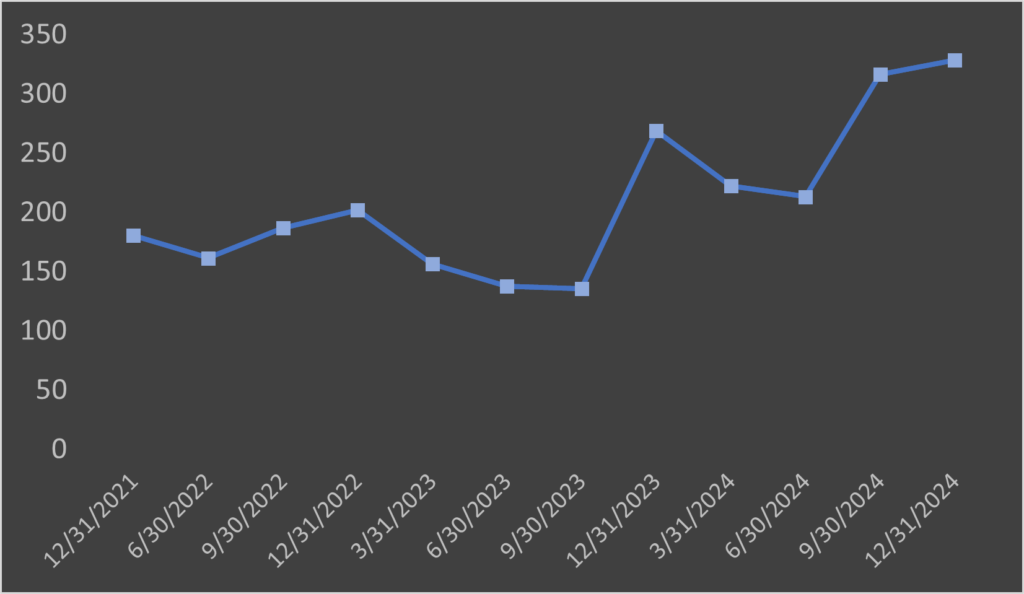
Intuitive Machines regularly reports backlog, but this metric may be less relevant than when examining backlog of other companies. Unexecuted task orders are not included in backlog, even though they are in some cases for Intuitive Machines almost certainly expected. NASA funds OMES III in chunks, and Intuitive Machines only includes the current chunk in its backlog. Intuitive Machines with high certainty will receive close or near-to-full contract value of $719m of OMES III, but they do not include this in backlog.
Lunar payload missions, CLPS revenue, and loss contracts
NASA CLPS contracts for delivering payload to the moon have been a bargain for NASA – costing less than traditional NASA managed missions for the same service. One reason is that multiple contractors, Intuitive Machines included, appear willing to deliver NASA cargo to the moon at a loss. U.S. firms eligible to bid on NASA CLPS contracts total 14. Old space players whose aim is to profit on government contracts – like Sierra Nevada Corporation and Lockheed Martin – have won no CLPS contracts. Instead start-ups like Intuitive Machines, Firefly Aerospace, Blue Origin and Astrobotic have won contracts, operating most if not all missions at a loss.
IM-1
NASA awarded Intuitive Machines $77m for its first lunar mission, IM-1, in 2019. Over time, NASA changed the project scope, modifying the contract value to $117.5m. NASA awarded Intuitive Machines an additional $4m to install a Radio Frequency Mass Gauge (RFMG) on the same mission. Thus Intuitive Machines’ revenue from NASA for IM-1 totaled $121.5m. Intuitive Machines reported receiving $10.8m in additional commercial revenue for the same mission.
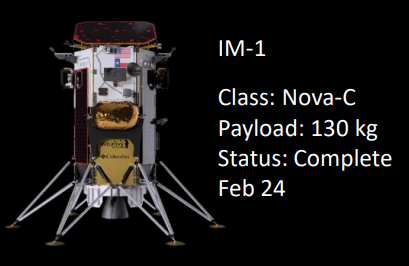
Prior to launch, Intuitive Machines’ SEC filings reported IM-1 carried $120.1 in revenue, plus $12.3m in constrained revenue. (Note: “not less than 10%” of NASA total CLIPS contract payment is contingent upon the contractor meeting certain pre-defined milestones. In other words, the final milestone payment of approximately 10% is payable should the contract successfully complete mission milestones.) IM-1 launched and made soft landing within the “Malapert A” crater in February 2024. Although landing softly, IM-1 crash-landed, tipping over onto its side. NASA still deemed IM-1 met project objectives and awarded final milestone payment. Constrained revenue converted to actual revenue maximizing Intuitive Machines’ revenue from IM-1.
IM-1 still was not profitable. Intuitive Machines noted in SEC filings that IM-1 became a “loss contract” in 2019. This corresponds to the same year NASA awarded the contract. Intuitive Machines almost certainly bid on and won this contract knowing it would operate at a loss. LUNR reported IM-1 loss charges between 2021 and end of 1H 2024 totaled -$4.4 million. (Loss charges in 2019 and 2020 are unknown.) Working back from these numbers, and noting IM-1 was already at a loss in 2019, we estimate IM-1 cost LUNR approximately $145m. With total revenue of $132.4, we estimate LUNR lost approximately $12.5m on IM-1.
IM-2
In 2020, NASA awarded $47m to Intuitive Machines to transport ice mining machinery to the lunar south pole. NASA followed up awarding $41.6m to LUNR to transport a lunar mobility vehicle, which will launch on the same mission. After additional contract modifications, both contracts now total $104m in potential revenue, assuming IM-2 meets all milestones. Intuitive Machines reports IM-2 is “sold-out” with commercial customer revenue totaling $31.8m. IM-2 will launch in 2025.
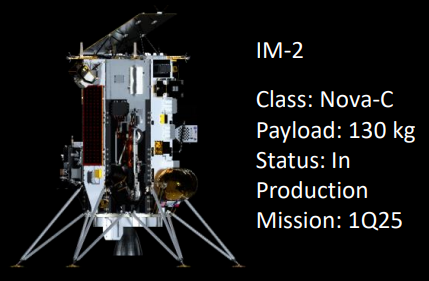
As of 3Q 2024, Intuitive Machines reported $122.6m in mission revenue for IM-2, with an additional $13.9m in potential constrained revenue. Assuming LUNR meets all milestones, total potential IM-2 revenue stands at $136.5m.
IM-2 is also a money loser for Intuitive Machines. Intuitive Machines noted in SEC filings that IM-2 became a “loss contract” in 2021 during which year they wrote down $19.3m in charges. However in 2022, LUNR recorded a positive $4.7m reversal. But in 2023 LUNR recorded $14.2m in further IM-2 loss charges. In 2024 through Q3, LUNR recorded $7.2m more in charges. Thus as of Q3 2024, IM-2 will lose $36m if it fails earning constrained revenue. If Intuitive Machines hits all milestones, IM-2 will instead lose $22.1m.
IM-3
In 2021, NASA announced selection of Intuitive Machines to transport 92kg of CLPS cargo to the moon for $77.5m. This contract since expanded, and currently stands at $86.5m. IM-3 will launch in 2025 or 2026.

As of 3Q 2024, Intuitive Machines reported NASA and commercial revenue for IM-3 totaled $93m, with an additional $9.7m constrained. Assuming full success of IM-3, total revenue could reach $102.7m.
IM-3 looks to be a third straight mission which will operate at a loss. Intuitive Machines disclosed in SEC filings that IM-3 became a “loss contract” in 2022 when they wrote down $6m in charges. In 2023 LUNR recorded $5.8m more in charges. Through third quarter 2024, LUNR recorded $9.9m more in loss charges. Thus LUNR stands to lose $21.7m on IM-3 with no constrained revenue. But if IM-3 hits all milestones, losses shrink to $12m. However, the possibility for smaller loss exists should LUNR sign new commercial customers for this mission between now and launch.
IM-4
NASA in August 2024 announced awarding Intuitive Machines a forth CLPS contract worth $116.9m. This contract makes LUNR NASA’s most contracted CLPS partner. LUNR has not yet disclosed in SEC filings whether or not IM-4 will operate profitably or at loss. Nor has LUNR announced any commercial payloads to rideshare on the mission.
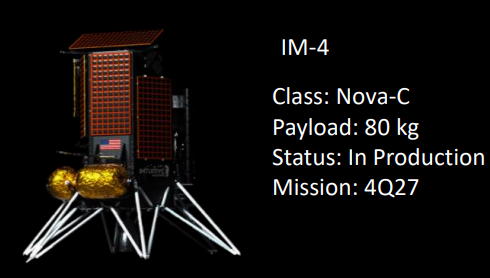
NASA’s OMES III contract
NASA awarded the five-year, $719 million maximum value OMES III contract to Space Networks Solutions LLC (SNS) in April 2023. Space Networks Solutions LLC (SNS), DBA Space & Technology Solutions, is a joint venture owned by Intuitive Machines (90%) and KBR, Inc (10%). (The exact entity of KBR co-owning SNS is not entirely clear from SEC filings. Another filing states KBR Wyle Services, LLC owns the 10% interest in SNS.) Under the contract, SNS will provide engineering support to NASA’s Goddard Space Flight Center, including for the Joint Polar Satellite System program. OMES II contract recipient Science Applications International Corp (SAIC) protested unsuccessfully after its lost its bid on OMES III.
Intuitive Machines and KBR agreed (via the “OMES III JV Agreement”) to execute the OMES III contract by splitting profits 47% for Intuitive Machines and 53% for KBR. Why Intuitive Machines owning 90% interest in SNS receives just 47% of OMES III profits is not clear from SEC filings. It is worth pointing out KBR is also an Intuitive Machines customer: “In the ordinary course of business, we regularly provide engineering services to KBR.”
Unlike LUNR’s CLPS contracts, OMES III is profitable. But only slightly. During 2023, LUNR reported that SNS had $12.5m in revenue (OMES III revenue started in 4Q 2023). However, operating profit was just $246,000. This equates to operating profit margin of 1.97%. At this rate, don’t expect OMES III to provide any substantial operating cashflow to LUNR.
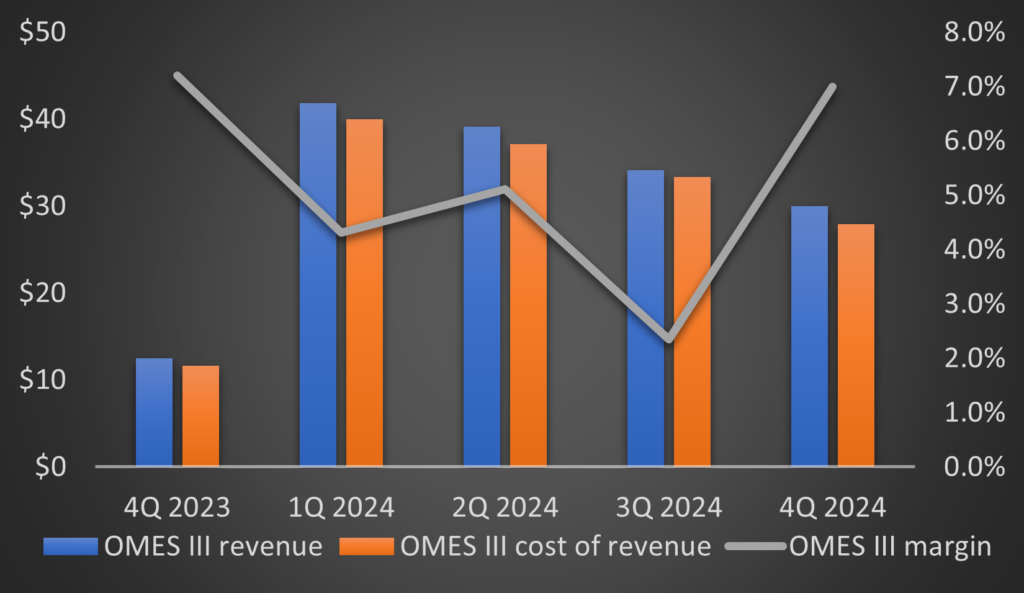
LUNR reports SNS operating profit yearly, not quarterly. So until the 2024 annual report becomes available, discerning whether SNS operating profits improved after 4Q 2023 is not possible. LUNR does however report OMES III revenue and “cost of revenue” quarterly. Subtracting OMES III cost of revenue from OMES III revenue gives stronger margins. It is not clear what “cost of revenue” excludes, other than depreciation which LUNR states in its filings. So investors must wait until March 2025 to see if operating profitability of OMES III changed since first month of contract inception. But based on what LUNR reported so far, the $719m OMES III contract appears to be padding LUNR’s top line without providing material profit to shareholders.
NASA Near Space Network (NSN) 2.2 – Cislunar Relay services contract
In September 2024, NASA announced awarding Intuitive Machines the Near Space Network (NSN) contract to provide lunar communication relay and navigation services. When NASA missions deploy to the moon, without line-of-sight, earth communication requires relay through orbiting lunar satellites. The NSN contract is fixed-firm price, with ceiling of $4.82b. The five year base period runs through September 2029, with five additional year extension available.
According to a NASA white paper, direct moon-to-earth communication from both the lunar south pole and orbiting satellite relays are envisioned. The same satellites will also provide position, navigation, and timing (PNT) services to spacecraft deploying to the moon. Prior to contract award, Intuitive Machines already planned placing a constellation of data relay satellites in orbit around the moon. In 2021, LUNR contracted with York Space to develop these satellites. LUNR currently plans five satellites in total, launching in stages. LUNR’s first data relay satellite will launch and deploy with CLPS mission IM-3. Two more satellites will launch with CLPS mission IM-4. And the final two will launch later on a yet to be confirmed mission.
Multiple competitors have announced plans to provide lunar data relay services, including ispace and Lockheed Martin. ispace will launch two data-relay satellites on its third mission (M3), planned for 2026. Lockheed Martin plans a similar data relay constellation through subsidiary Crescent Space Services. Intuitive Machines and ispace seemingly have an advantage, able to piggyback satellite launches with lunar cargo launches. Lockheed apparently will require standalone launch(es) to deploy its satellite constellation, likely at added cost.
Forecasting Intuitive Machines’ revenue or profit from the NSN contract is murky. The initial contract totaled up to $584.9m, but NASA has obligated just $5m so far. If Intuitive Machines earns the full $579.9m over five years, this potentially could increase yearly revenue by over 50%.
Intuitive Machines provided some clarity during its 2024 Q3 conference call Q&A. CFO Pete McGrath stated the first task order totals ~$9m over six months. The second task order is for an additional ~$18m over six more months. Then the third task order for $43.5m requires LUNR completing in-lunar-orbit verification of its first satellite. With the first lunar satellite launching with IM-3 in early 2016, Intuitive Machines stands to realize ~$70.5m in revenue through 2Q 2024. A forth $61.5m task order is for deployment and verification of satellites two and three (launching on IM-4). The final fifth task order is for $18m and involves deployment of the final satellites and full constellation operation capability demonstration. Afterward Intuitive Machines can then sell to NASA data transfer and positioning services, earning additional revenue under the contract.
LUNR’s three current primary revenue sources are lunar payload transport (CLPS contracts), OMES III, and this NASA NSN lunar data relay contract. LUNR operates its CLPS contracts at losses. However, the cost of these launches help subsidize launch cost and transport of the NSN satellites to the moon. OMES III is profitable, but the margins are so small that the profit appears immaterial. If Intuitive Machines can operate NASA cislunar services contract in the black, it offers shareholders best hope for a profitable business line.
Management guidance scorecard

Intuitive Machines management’s record of providing accurate and worthwhile forecasts is not good. Pre-IPO, management provided investors 2023 and 2024 annual revenue numbers that proved later 3x overstated. Management’s launch guidance is regularly off, with three projections missed due to mission delays.
Board member Michael Blitzer in September 2022 stated, “Intuitive Machines believes that its growth plan will be fully funded to profitability over the next two to three years.” Going on three years out from his statement, Intuitive Machines appears no nearer to profitability.
Post IPO, Intuitive Machines put the brakes on providing guidance. The announced none between May 2023 and May 2024. Arguably no guidance is better than issuing wrong guidance. When Intuitive Machines resumed guidance in May 2024, it was not multiyear and management quit EBITDA and gross margin forecasts.
CEO Stephen Altemus compensation
| Salary | Bonus | Options | Other | Total | |
|---|---|---|---|---|---|
| 2021 | $452,113 | $100,000 | $8,700 | $560,813 | |
| 2022 | $490,954 | $150,000 | $10,675 | $651,629 | |
| 2023 | $699,377 | $15,106 | $714,483 |
Stephen Altemus’s salary is comparatively modest to other space stock CEOs. He holds 910,919 shares, worth about $20m. Thus his financial incentive rests on growing shareholder value. Growing share vale offers opportunity to increase his wealth far greater than kicking back and collecting salary. And the stock price under Altemus’s leadership has indeed risen, something that cannot be said for many U.S. space SPACs.
Intuitive Machines outlook and risk assessment
Intuitive Machines appears neither on path to profitability nor positive free cash flow. However the company is set for significant top line revenue growth due to recent NASA contract wins (OMES III and NSN).
- Intuitive Machines first lunar payload mission lost money. LUNR already categorizes its next two missions as loss contracts. OMES III operates with only slight profitability (but majority of profits distribute to LUNR’s partner, KBR). And the first three years of the NSN contract are dubious: will $150m cover cost to build, launch and deploy five lunar orbit satellites and leave any profit?
- In August 2024, LUNR advised holding cash for 12 months of operations. This suggests additional funding will be needed to fund the company beyond 12 months. This fact is consistent with LUNR internally forecasting continued negative cashflow.
- Luckily, investor interest in Intuitive Machines is extremely high. This interest allowed LUNR to successfully raise money through its at-the-market offering. LUNR has sold shares to investors who continue to buy them, shoring up LUNR’s cash position. Continued ability to raise money from selling stock will necessary to offset losses from core missions.
- Shareholders should expect future dilution. However, severe dilution since IPO has shown no signs of hurting LUNR’s stock price.
- CEO Steve Altemus stated pre-IPO that 80% of Intuitive Machines’ revenue sources from the government and 20% from the commercial sector. Commercial contribution appears overstated, especially in light of the NASA OMES III and NSN contracts. Intuitive Machines likely sources 90-95% of its revenue from the government. Thus policy change or differences in NASA spending could materially impact LUNR.
- Nonetheless, Intuitive Machines clearly currently is the leading cis-lunar commercial space company. No other private company has put a craft on the moon. Two have tried and failed (ispace and Astrobotic).
- Compare Intuitive Machines with ispace. After IM-1 landed softly, Intuitive Machines announced selling out commercial payload capacity on IM-2. Conversely, after ispace’s M1 crash-landed creating a debris field near the Atlas crater, ispace subsequently sold just 2.5kgs of payload across its second and third planned missions.
- LUNR’s NSN contract, even if it operates at a loss, is a huge win. Competitors ispace and Lockheed Martin each seek establishing their own lunar data relay constellations but are at a $150m disadvantage. Under LUNR’s NS contract, NASA basically subsidizes Initiative Machines’ lunar satellite constellation and then pay to use it. ispace’s M1 failed and LUNR’s IM-1 nearly failed due to inability to properly calculate altitude during decent. Future lunar lander missions can (pay to) use Intuitive Machine’s lunar satellite constellation to get accurate positioning data alleviating this risk And missions to the far side of the moon will require data-relay satellites to communicate with earth. (Granted, south pole missions are of greater interest that far side.)
- Blue Origin will likely be the biggest future competitor. With seemingly unlimited budget from founder Jeff Bezos, Blue Origin engineered its MK1 lander to transport 3000 kg of payload. This is roughly equivalent to 23 Intuitive Machines’ Nova-C missions. The first Blue Origin MK1 mission launches in 2025.

Thesis: OMES III is primary a revenue driver but nothing that will make LUNR rich. If a new lunar economy really is coming, Intuitive Machines’ early success and current NSN contract positions LUNR well. Capital (read: stock dilution) will be needed to offset losses of lunar payload missions. But the same may be said for all current companies competing to provide lunar transport services. The main risk involves how long until a commercially sustainable lunar economy presents itself. And how much money Intuitive Machines will need to maintain operations until then.
What to look from Intuitive Machines going forward
Aside from the obvious – missions IM-3 and IM-4 succeeding – shareholders should considering looking for the following:
- Competitor missions. When ispace’s first mission failed, customers with non-binding interim payload service agreements on ispace’s second mission apparently bolted. Alternatively Intuitive Machines after its first mission sold out its second mission. Customers want heritage and proven success. If Intuitive Machines’ competitors (ispace, Astrobotic, Firefly Aerospace, Blue Origin) fail, more commercial (and NASA) demand likely will swing towards Intuitive Machines. Likewise if competitors are successful, oversupply in payload capacity may create downward pressure on commercial payload costs, and too, on Intuitive Machines revenue.
- How does Intuitive Machines spend its “fortress like” amount of cash? (They announced in 1Q 2025 investing in an orbital transfer vehicle with a customer already lined up.)
- OMES III profit margins.
- Does IM-4 slip becoming a loss contract?
Recent News
-
Intuitive Machines 2024 financials: cash, IM-4 profitability, and (DOD) OTVs
Intuitive Machines (NASDAQ: LUNR) released 2024 annual financial and investor slides last week. As well reported, forth quarter revenue increased 79% year-over-year. The stock jumped 24%…
-
Intuitive Machines second mission loss at least $22m
As already well-covered, Intuitive Machines (NASDAQ: LUNR) second mission, IM-2, tipped over on landing. Two missions, both with same result. Intuitive Machines, seven hours after…
-
Sidus Space releases new investor presentation
Likely connected with the pending public offering, Sidus Space (NASDAQ: SIDU) posted a new investor presentation. Three things immediately stand out: Sidus’s new larger satellite…
-
AAC Clyde Space sells four more Starbuck power systems (€1.025m)
AAC Clyde reports sale of 4 Starbuck power systems, plus services, for €1.025m (approx. SEK 11.6 M). Revenue is expected to be recognized in the…